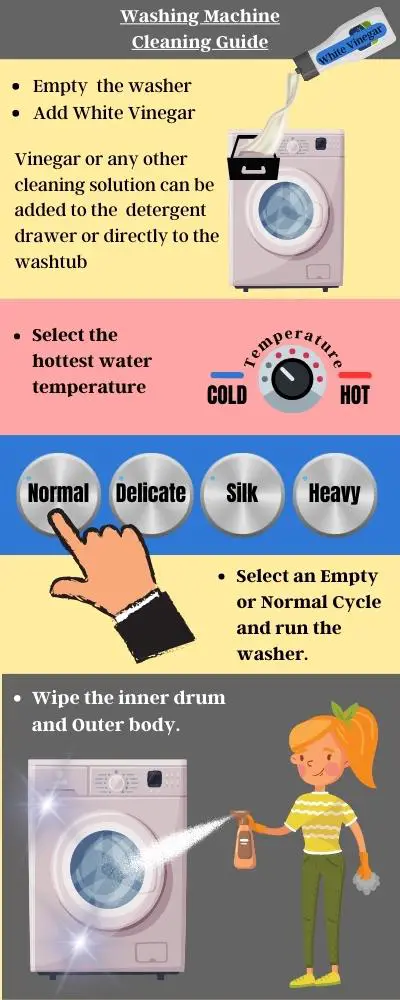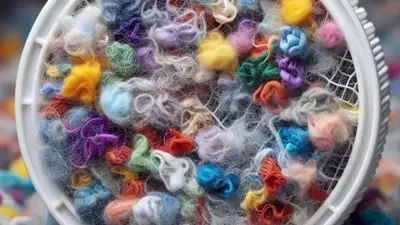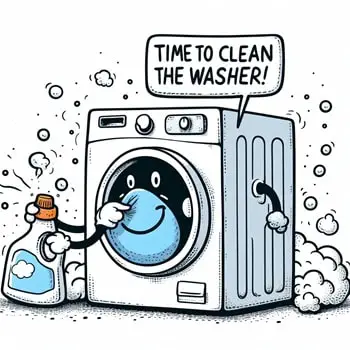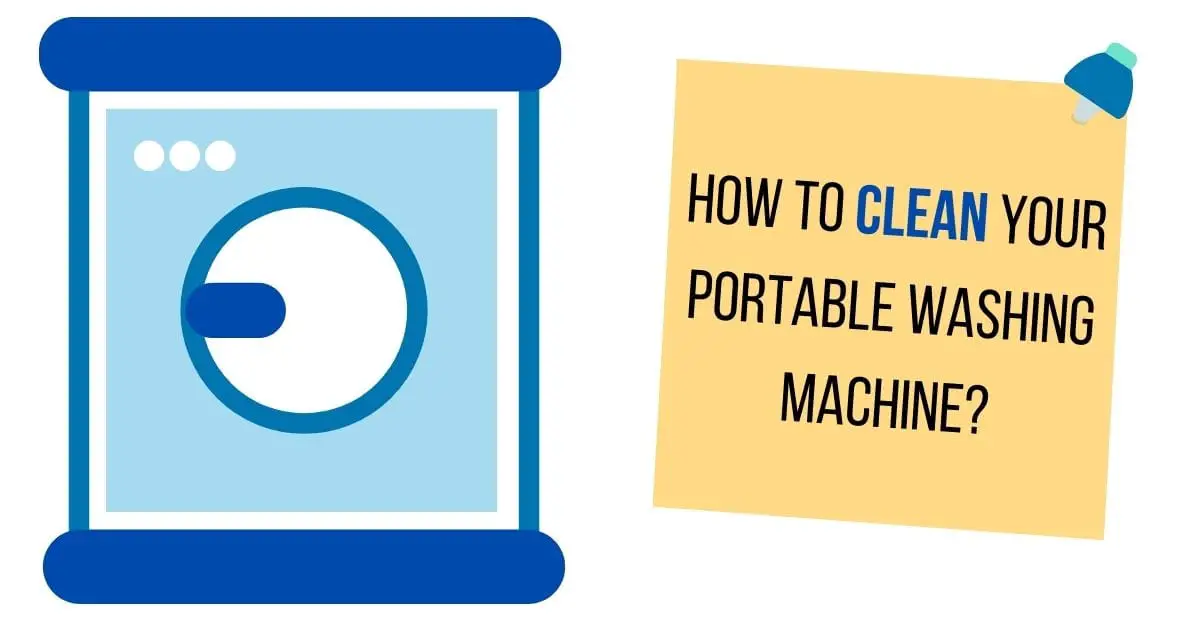Portable washing machines, which are compact laundry appliances, offer a convenient and efficient way to clean your clothes in the comfort of your home.
They make the laundry process more convenient and efficient, saving both time and effort.
All you need to do is place your soiled garments inside, add detergent, and effortlessly initiate the cleaning cycle by pressing a button.
What’s next?
Your garments will emerge fresh and spotless, typically within a matter of minutes or a few hours, contingent upon the load’s size and the chosen washing cycle.
Since the Portable washing machine’s work is to clean clothes, one might think that it is unnecessary to keep it clean.
In reality, the dirt and odor from your outfits build up over time, and it can cause the machine to lose its efficiency.
The prolonged accumulation of dirt also provides a breeding ground for harmful organisms like bacteria and mold.
Besides, the accumulated dirt can also spoil the clothes you put in the washing machine.
This explains the importance of cleaning your portable appliance regularly.
So how do you clean a portable washing machine in an efficient and effective way?
The fastest and best way to clean a portable washing machine is by using vinegar and baking soda.
To clean your portable washer:
- Empty the washing machine’s drum.
- Add 2 cups of distilled white vinegar to the detergent dispenser or directly add it to the drum.
- Set the temperature to the highest setting and let the machine fill with hot water.
- Run the washing machine on an empty cycle or normal cycle for at least 2-3 minutes.
- Drain the water from the drum and let the machine cool down.
- Start wiping the inside of the drum using a damp cloth.
- Now add 1 cup baking soda to the drum and repeat the process.
- Lastly, run an empty cycle using plain water (without baking soda, vinegar, or any other solution).
- Doing this will help remove the remains of baking soda and vinegar.
- Wipe the inside of the drum thoroughly.
- Once the interior is clean, wipe the exterior with a clean cloth.
Note: Avoid mixing the solutions (Vinegar and Baking soda together) in the cleaning process.
As a best practice, you should always clean the washing machine internally first, followed by its exterior or outer body.
If you start with the exterior, the interior’s dirt could make the exterior murky, forcing you to start over the process.
Let’s get started with the comprehensive guide on cleaning your washer…
Table of Contents
Quick Illustration showing how to clean your portable washing machine

How to Clean the Interior of a Portable Washing Machine?
For safety reasons, ensure that your portable washer is unplugged from the power source before you start cleaning.
The appliance must also be empty to make sure that the cleaning process is effective.
Also, it’s important to know that even though the interior of the washing machine can be cleaned by running an empty cycle using hot water, there are a few components that need special attention such as the detergent dispenser, gasket rubber (door seal), and the inner wall of the washing machine’s drum.
Over time, the rubber seal area is prone to accumulate the buildup of mold due to trapped water between the machine and the seal.
Likewise, the soap dispenser also gets murky because of the clogging of dirt, detergent residues or traces of soap, and other debris.
So, once you have unplugged the washer, here’s what you should do ideally:
To clean the door seal
- Mix a cleaning solution in a bowl filled with water.
- Next, dip a sponge in the solution and apply it thoroughly around the seal to remove any build-up, and leave it to settle for some time.
- Sprinkle some water and scrub it with a clean sponge or a soft brush.
- Finally, wipe it with a clean cloth.
Note: You can also use and apply a thick paste of baking soda
To clean the detergent dispenser
- Dip a clean cloth in a mixture of water and a suitable cleaning solution.
- Scrub the dispensers thoroughly but without applying too much pressure.
- Leave it to settle for some time and rinse it with clean water.
To clean the internal walls of the drum
- You can either use a sponge or a soft cloth and dampen it in the mixture of cleaning solution and water.
- Scrub and apply the solution to the internal walls of the wash drum thoroughly. You might also need a soft brush to scrub over the stubborn stains and build-ups around the corners of the wash drum.
Note: Avoid using abrasive cleaners or rough scouring pads since they can damage the machine.
Running a cycle
- Make sure the washer is empty from any loads and plug in the washer to power.
- You can start by, running a normal wash cycle using hot water only (without adding detergent or any other cleaning solution).
- Once the cycle completes add your preferred cleaning solution.
- After adding your desired solution, run the cycle for a few minutes to allow the solution to mix well with water.
- Now, leave the washer idle for about an hour as it will help the cleaning solution to loosen and remove the grime and build-ups.
- Next, run a rinse-only cycle and drain the water from the drum.
- Finally, run a normal cycle using water only to get rid of any remains of the solutions and grime.
Note: Apart from readily available cleaning solutions, you can also choose either bleach or vinegar, as both are useful in removing calcium stains (limescale buildup) and soap scum (detergent residues).
How to clean the hoses of a washing machine?
The washing machines typically include two types of hoses that serve different purposes i.e., water inlet and drain hoses.
In most high-end washing machines, there are two water inlet hoses for both hot and cold water supplies.
Similarly, you will find a hose that drains the used water from the wash drum as well.
So, cleaning these hoses regularly plays an important role in the overall functioning of the washing machine.
Here’s how you can clean both washing machine hoses:
Water inlet hoses
Water inlet hoses are usually connected to the washing machine through inlet valves and the other end connects the water supply source.
Over time, tiny debris and mineral deposits accumulate and build up, especially near the inlet valves, and prevent the water from flowing to the machine.
Depending on your washer model and type you can locate and remove the hoses from the machine and follow the below steps for cleaning.
- Unplug the washer from power and remove the water inlet valve and hoses.
- Soak the valve and the hoses in a tub filled with warm water and a cleaning solution.
- Additionally, the inlet valve includes a small filter screen which prevents debris from entering the machine.
- Dip the filter screen in soapy water and let it sit for some time.
- Next, is to rinse the screen thoroughly with clean water and let it dry.
- Using a sponge or a soft brush scrub the inlet valve to remove any build-up.
- Rinse the hoses and valves thoroughly and fix them back to their original places.
Drain Hose
To clean the drain hoses you can follow the below steps:
- Make sure the washing machine is unplugged from power and then locate the drain hose in your washing machine.
- You can refer to the user manual of your washing machine model and type to locate and remove the drain hose.
- Soak the drain hose for about 30 minutes in a bucket filled with slightly hot water and cleaning solution.
- Scrub the drain hose using a soft brush and place it under a running tap. Let the water flow through the hose.
- If the drain hose is clogged then you can also make use of a plumbers snake to remove the clogging.
- After rinsing the hoses thoroughly fix it back to its place carefully.
READ: Portable Washers: How They Work & their working principles
How to clean the lint filter?

With most brands, by design lint filters can be found at the bottom.
Having said that, cleaning the lint filters can be very easy.
Simply detach the lint filter and wash it thoroughly under running tap water and you should be good.
Let’s go through the detailed cleaning steps below:
- Unplug the washer from power and detach the lint filter carefully.
- Make sure to follow the instructions from the user manual below, especially to locate and detach the filter as not all filters are detachable.
- So, once the filters are detached, they can be thoroughly washed simply under running tap water.
- If the filter is in extremely bad shape, you may need to wash it a couple of times using water and vinegar.
Note: Soaking the filter for about 30 minutes in a cleaning solution mixed with water is more than enough in most cases. Make sure to rinse the filter thoroughly with clean water.
We have found a nice video that shows, how to clean the lint filter (This video is for front load washer, but the process to clean the filter remains the same).
Ok, once you are done cleaning the interior and the Lint filter, the next thing is to complete the final step.
The last step is to clean the exterior.
READ: How to Hookup a Portable Washing Machine?
How to Clean the Exterior of a Portable Washing Machine?
Besides making your laundry room hygienic, cleaning the exterior of your portable washing machine helps remove the dirt that falls off your clothes and detergent residue.
Like the interior, you must start by unplugging the appliance from the main switch to prevent electrocution.
Then, turn off the inlet faucet that supplies water to the machine.
Once you cut the water supply, boil water, and add either vinegar or bleach to form a cleaning solution.
Soak a cloth into the mixture and use it to remove dirt and stains on your washing machine’s outer surface.
If you wish to, you can add a washing detergent to make the work easier.
The last step involves cleaning the pipe connections and corners of your washing appliance and leaving it to dry.
Remember to open the lid to ensure that the interior dries too.
READ: How to Use a Portable Washing Machine Effectively?
How to Prevent Bad Odor Buildup in Your Portable Washer?

The most effective method of preventing the buildup of unpleasant smells in your washing machine is by keeping the door open when it is not in use. Closing the door after use traps moisture inside, providing the ideal breeding conditions for bacteria and mold that cause the foul odor.
On the other hand, opening the door allows the water to evaporate and keeps your appliance fresher.
Another way of ensuring your machine remains fresh is by removing your clothes immediately after washing.
Leaving your wet outfits inside for an hour can lead to the growth of mold and bacteria.
These organisms make your machine less effective, and your clothes smelly.
Lastly, you can use scented detergent or lemon juice whenever you clean your washing machine.
The pleasant fragrance produced by these products will keep your washer fresh and appealing.
If you are still facing issues with Odor even after following the above steps, we would recommend you check our troubleshooting guide, it covers other aspects of issues commonly faced by many users.
READ: 12 Answers you must know about Laundry Pods
Maintaining the Cleanliness of a Portable Washing Machine
While cleaning your machine is mandatory in maintaining its effectiveness, it is a tedious and time-consuming process.
Nobody wants to do it every other time.
The best way to keep your machine tidy is by emptying it immediately after use.
As mentioned above, damp clothes cause foul odors and promote the growth of bacteria and mildew.
Additionally, always keep the lid open to facilitate evaporation and prevent the breeding of bacteria.
More importantly, ensure that you use the machine for its designated purpose.
Some people use these appliances to clean backpacks, sneakers, jackets, toys, and so forth.
Though these items might fail to cause noticeable damage at first, they can destroy the machine after extensive use.
READ: What is RPM in Washing Machine?
How Often Should You Clean Your Portable Laundry device?
It is crucial to regularly clean your washing machine, the same way you do to other domestic appliances like dishwashers, microwaves, and refrigerators.
The frequency at which you wash your device depends on how much you use it.
In an average household, the recommended frequency is twice monthly.
Final Thoughts
Keep in mind that regular cleaning extends your machine’s lifetime and prevents the accumulation of mold and unpleasant odors.
Hope we have answered the query 🙂
If you have more questions, there are high chances that they may have already been answered in our Portable Washers FAQ section.

